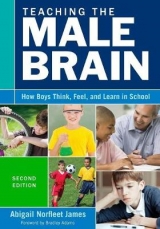
Teaching the Male Brain
Corwin Press Inc (Verlag)
978-1-4129-3663-7 (ISBN)
- Titel erscheint in neuer Auflage
- Artikel merken
′This book is well written, well organized, includes legitimate scientific references, and is full of practical suggestions′ - David Sousa, Educational Consultant, Author, How the Brain Learns, Third Edition
Differentiate your teaching style to address learning differences between girls and boys in the classroom!
As a classroom teacher, you might know that boys learn differently from girls. Now, this practical guide to teaching boys combines classic with cutting-edge research to show you why boys learn differently and, more importantly, how you can differentiate teaching strategies to help boys succeed in the classroom.
The author′s qualitative and quantitative research shows the cognitive, sensory, physical, social, and emotional differences between genders. James draws from years of classroom experience to offer strategies that have been tested, refined, and used successfully in the field. This easy-to-use handbook provides helpful examples, case studies, and troubleshooting sections illustrating how to handle the concerns that can arise when teaching boys.
Teaching the Male Brain shows you how to:
o Recognize sociological and neurobiological foundations of cognitive gender differences as they relate to education
o Look critically at curricula and teaching practices, evaluate how well they work with boys, and uncover areas where changes can be made
o Develop educational approaches based on research and classroom practice to provide a climate responsive to the learning differences of both boys and girls
Learn to use this brain-based research to provide appropriate and positive learning experiences for the students in your classroom!
Abigail Norfleet James taught for many years in single-sex schools and consults on the subject of gendered teaching to school systems, colleges, and universities. Her area of expertise is developmental and educational psychology as applied to the gendered classroom. Prior to obtaining her doctorate from the University of Virginia’s Curry School of Education, she taught general science, biology, and psychology in both boys’ and girls’ schools. Her previous publications include reports of research comparing the educational attitudes of male graduates of coed schools and single-sex schools, research describing the effects of gendered basic skills instruction, and a report of academic achievement of students in single gender programs. In addition, she has written on differentiated instruction at the elementary school level. She has presented workshops and papers at many educational conferences and works with teachers and parent groups in interpreting the world of gendered education. Her professional affiliations include the American Educational Research Association, the American Psychological Association, the Association for Supervision and Curriculum Development, the Coalition of Schools Educating Boys of Color, the Gender and Education Association, the International Boys’ Schools Coalition, and the National Association for Single-Sex Public Education (Advisory Board Member).
Foreword
Acknowledgements
About the Author
Introduction
Substantiating Research
How the Book Is Structured
Learning Objectives
Part I: Sex and Gender Differences in the Classroom
1. Brain Basics
Are Brains Gendered?
Anatomy of the Brain
Sex Differences in Brain Function
Cognitive Skills
2. Sensory Differences
Vision
Hearing
Touch
Learning Modalities
Sensory Systems and Learning
3. Physical Differences
Activity Levels
Gross Motor Development v. Fine Motor Development
Targeting
Handedness and Dexterity
Growth Patterns
Physical Differences and Learning
4. Cognitive Differences
Verbal and Language Skills
Practice the Skills Necessary for the SAT and Other Standardized Tests
Spatial Abilities
Learning Modalities
Strategy Development
Cognitive Differences and Learning
Part II: Societal and Biological Influences
5. ADHD and Learning Disabilities
Attention – ADHD
Medication
The “At-Risk” Student
Attentional and Learning Problems
6. Social and Emotional Differences
The Brain and Emotions
Emotional Vocabulary
Aggression and Bullying
Competition and Cooperation
Puberty
Alcohol and Drugs
Social Influence on School
School and Masculinity
Learning Applications
Emotions and Learning
7. Students With Other Risks
Teachers
Culture
Adults
Boys With Cultural, Linguistic, or Socioeconomic Differences and School
Part III: Strategies and Resources for Teaching the Male Brain
8. Classroom Management Strategies
Home Influence
Discipline
Technology
Classroom Management and Learning
9. Content-Specific Suggestions
English/Language Arts
Mathematics
History/Social Studies
Science
Foreign Languages
Fine Arts, Music, and Drama
Computer Skills
Individual Disciplines and Learning
10. Effective Teaching
Differentiated Instruction
Multiple Intelligences
Learning Modalities
Unit Design
Empowering Boys as Learners
Test-Taking Strategies
Final Words
11. Resources and Other Helps
Books of Interest
Rubrics
Learning style Assessments
Resources
References
Index
| Erscheint lt. Verlag | 16.5.2007 |
|---|---|
| Verlagsort | Thousand Oaks |
| Sprache | englisch |
| Maße | 177 x 254 mm |
| Gewicht | 640 g |
| Themenwelt | Geisteswissenschaften ► Psychologie ► Pädagogische Psychologie |
| Sozialwissenschaften ► Pädagogik | |
| ISBN-10 | 1-4129-3663-2 / 1412936632 |
| ISBN-13 | 978-1-4129-3663-7 / 9781412936637 |
| Zustand | Neuware |
| Informationen gemäß Produktsicherheitsverordnung (GPSR) | |
| Haben Sie eine Frage zum Produkt? |
aus dem Bereich



